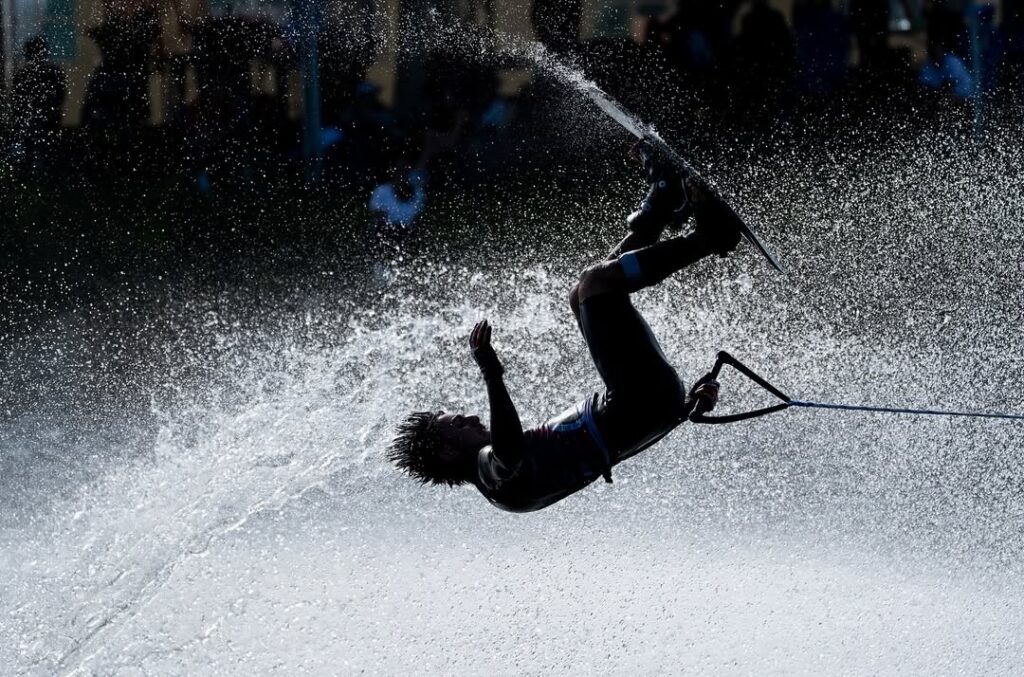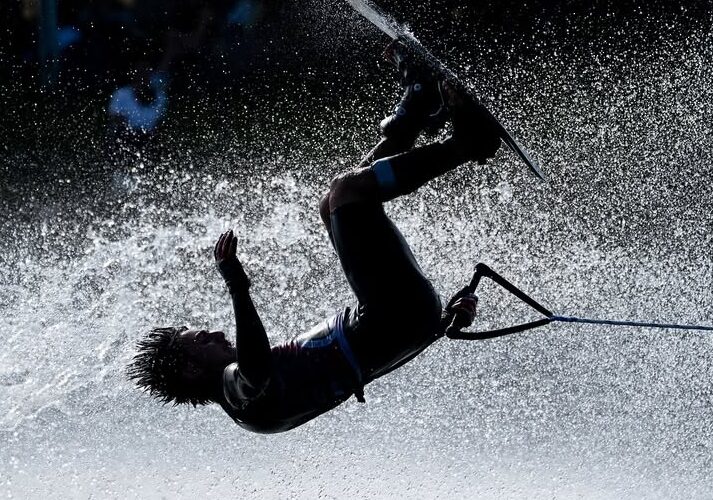Axel Garcia: The King of the Half Jack

Axel Garcia tricks during the IWWF U21 waterski championships (image: @bearwitnesssportsphotos)
By Jack Burden
When the conversation turns to innovation in modern trick skiing, it almost always starts with Joel Poland. The multitalented Brit has made “super flips” part of the sport’s everyday vocabulary, turning his signature super-mobe-five into a tournament staple.
But there’s another name worth saying—one rising fast.
Seventeen-year-old Axel Garcia of France has been quietly building a résumé that demands attention. Third at last year’s Under-17 Worlds behind Mati Gonzalez and Jake Abelson. Multiple-time European champion. Top seed into the finals at the recently concluded Under-21 World Championships.
And above all, he’s developed a reputation for one thing: launching himself into frontflips with the kind of style and ease that makes fellow skiers double-take.
Among elite trick skiers, Garcia has been dubbed by some as the “King of the Half Jack.” The half jack—named after American skier Kevin Jack—is a frontflip variation where the skier edges into the wake from an inverted back position before throwing the flip. It’s a close cousin to the wakeboard “tantrum” and has quietly become one of the most common moves in top-level runs. These days, a mobe–reverse–half jack combo is almost as standard as a side slide.
Some, like world record holder Jake Abelson, still favor the more orthodox BFF (frontflip from a regular back position), but that’s becoming rare. The half jack’s speed, consistency, and smooth transition make it the go-to choice.
Garcia hasn’t just mastered it—he’s reinvented it. In 2023, he submitted a clip of himself landing a reverse FFLF, which the IWWF approved as a brand-new trick.
Recently, he posted an Instagram video that made waves: both regular and reverse FFLFs, plus both regular and reverse FFLBBs (frontflip 360s), all starting from the inverted back like a half jack. The reverse FFLBB isn’t even in the rulebook yet—but if Garcia submits it, he could add another flip to the official trick list.
Top names took notice. Pato Font, Mati Gonzalez, and Neilly Ross all jumped into the comments with praise.
Garcia’s skillset is a case study in a long-running debate: whether the IWWF’s trick scoring table needs an overhaul.
Take backflips. Progressing from a basic backflip (BFL) to a backflip 540 (BFL5F) is worth 350 more points—about a 70% increase. But frontflips? A basic FFL is worth 800 points. The 540-degree version (FFL5F) gets just 150 more—less than a 20% bump.
Why? Because of an arbitrary 1,000-point ceiling. Years ago, the double backflip was set at that max value, despite no skier ever landing it. Since then, every trick has had to fit between 500 and that cap, squeezing the spread for higher-difficulty frontflips into a narrow range.
The result: Garcia gains little by throwing his most jaw-dropping tricks. At the Under-21 Worlds, he topped the prelim leaderboard with a run of safe, fast mobes, half-twists, and just two frontflips. Why risk a reverse half jack or a front-full for an extra 100–150 points when a 750-point half-twist is cleaner and safer?
He’s not alone. Abelson regularly posts outrageous frontflips online—no-wake FFLBs, front-fulls from a regular wrap—that never see a start dock in competition. Pato Font has ski-line and spin variations that would make even Cory Pickos jealous. Every top trick skier has an ace or two they leave at home on tournament day.
Part of the reason is difficulty: in trick skiing, you can’t afford an early fall. Speed and consistency win. That’s not a flaw—it’s part of what makes the sport thrilling. But with a different point spread, more of those “party tricks” could become prime-time tricks.
Axel Garcia is exactly the kind of skier trick skiing’s future needs—innovative, fearless, and stylish. His flips are already redefining what’s possible off a ski wake, even if the scorebook hasn’t caught up.
For now, his wildest moves might remain for Instagram. But if the sport wants its brightest stars to keep pushing the limits, it needs to make sure the risk is worth the reward.
Because Garcia may not just be the King of the Half Jack—he might be next in line for the whole trick skiing crown.


Axel, is a future crack of tricks skiing. Even more impressive, when you know he trains
with his dad in the Northern Hempishere, in the cold winter…